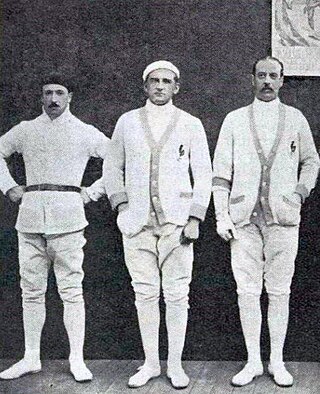
The men's épée was one of four fencing events on the Fencing at the 1908 Summer Olympics programme. The competition was held from 17 to 24 July 1908 at the Franco-British Exhibition fencing grounds. There were 85 competitors from 13 nations. Each nation could enter up to 12 fencers. The medals were swept by the French fencers, who also took the gold medal in the team épée event. Gaston Alibert was the gold medalist, with Alexandre Lippmann taking silver and Eugene Olivier bronze. Officially, it was the second consecutive medal sweep in the event, though two of the three "Cuban" fencers who medaled in 1904 were actually American.

The men's sabre was one of four fencing events on the Fencing at the 1908 Summer Olympics programme. The top two places were won by Hungarian fencers, who also took the gold medal in the team sabre event. Jenő Fuchs took the gold medal and Béla Zulawszky the silver. Bronze went to Bohemian Vilém Goppold von Lobsdorf. There were 76 competitors from 11 nations. Each nation could enter up to 12 fencers.

The men's épée was a fencing event held as part of the fencing at the 1920 Summer Olympics programme. It was the fifth appearance of the event. A total of 80 fencers from 13 nations competed in the event, which was held from August 20 to 23, 1920. Each nation was limited to eight fencers, down from 12 in 1908 and 1912. Of the six fencing events, the only one in which Nedo Nadi did not win a gold medal was the one in which he did not compete. Instead, a trio of Frenchmen swept the medals. It was Lippmann's second silver medal in the event, he having previously taken second in 1908; he was the second man to win multiple medals in the individual épée.
The men's team foil was one of seven fencing events on the Fencing at the 1928 Summer Olympics programme. It was the fourth appearance of the event. The competition was held from 29 July 1928 to 30 July 1928. 88 fencers from 16 nations competed.
The men's team sabre was one of seven fencing events on the Fencing at the 1928 Summer Olympics programme. It was the fifth appearance of the event. The competition was held from 8 August 1928 to 9 August 1928. 65 fencers from 12 nations competed.

The men's épée was one of seven fencing events on the fencing at the 1936 Summer Olympics programme. It was the ninth appearance of the event. The competition was held from 9 August 1936 to 11 August 1936. 68 fencers from 26 nations competed. Nations were limited to three fencers. The event was won by Franco Riccardi of Italy, the nation's second consecutive victory in the men's épée. Riccardi's teammates Saverio Ragno and Giancarlo Cornaggia-Medici took silver and bronze, respectively, to give Italy a medal sweep—Italy's first and the fourth overall in the event. Cornaggia-Medici, who had won gold in 1932, became the fourth man to win multiple medals in the individual épée. For the first time, France competed in the event but did not win any medals.
The men's team foil was one of seven fencing events on the fencing at the 1936 Summer Olympics programme. It was the sixth appearance of the event. The competition was held from 2 to 4 August 1936. 99 fencers from 17 nations competed. Each team could have a maximum of six fencers, with four participating in any given match.
The men's team sabre was one of seven fencing events on the fencing at the 1936 Summer Olympics programme. It was the seventh appearance of the event. The competition was held from 12 August 1936 to 13 August 1936. 107 fencers from 21 nations competed. Each team could have a maximum of six fencers, with four participating in any given match.

The men's épée was one of seven fencing events on the fencing at the 1948 Summer Olympics programme. It was the tenth appearance of the event. The competition was held from 7 August 1948 to 9 August 1948. 66 fencers from 25 nations competed. The event was won by Luigi Cantone of Italy, the nation's third consecutive victory in the men's épée. Italy also earned its third consecutive bronze medal in the event, with Edoardo Mangiarotti's third-place finish. Between the two Italians was Oswald Zappelli of Switzerland, taking the silver medal.
The men's team épée was one of seven fencing events on the fencing at the 1948 Summer Olympics programme. It was the eighth appearance of the event. The competition was held from 5 August 1948 to 6 August 1948. 113 fencers from 21 nations competed.
The men's team foil was one of seven fencing events on the fencing at the 1948 Summer Olympics programme. It was the seventh appearance of the event. The competition was held from 30 July 1948 to 31 July 1948. 82 fencers from 16 nations competed.
The men's team sabre was one of seven fencing events on the fencing at the 1948 Summer Olympics programme. It was the eighth appearance of the event. The competition was held from 10 August 1948 to 11 August 1948. 85 fencers from 17 nations competed.
The men's team sabre was one of seven fencing events on the fencing at the 1952 Summer Olympics programme. It was the ninth appearance of the event. The competition was held from 29 July 1952, to 30 July 1952. 85 fencers from 19 nations competed.
The men's team foil was one of seven fencing events on the fencing at the 1956 Summer Olympics programme. It was the ninth appearance of the event. The competition was held 23 November 1956. 50 fencers from 9 nations competed.
The men's team épée was one of seven fencing events on the fencing at the 1956 Summer Olympics programme. It was the tenth appearance of the event. The competition was held on 28 November 1956. 55 fencers from 11 nations competed.
The men's team sabre was one of seven fencing events on the fencing at the 1956 Summer Olympics programme. It was the tenth appearance of the event. The competition was held on 3 December 1956. 43 fencers from 8 nations competed.
The men's team foil was one of eight fencing events on the fencing at the 1960 Summer Olympics programme. It was the tenth appearance of the event. The competition was held on 2 September 1960. 77 fencers from 16 nations competed.

The men's team épée was one of eight fencing events on the fencing at the 1960 Summer Olympics programme. It was the eleventh appearance of the event. The competition was held on 9 September 1960. 105 fencers from 21 nations competed.

The women's team foil was one of eight fencing events on the fencing at the 1960 Summer Olympics programme. It was the first appearance of the event. The competition was held on 3 September 1960. 57 fencers from 12 nations competed. The winner of the tournament was the Soviet Union, followed by Hungary and Italy in third.
The men's team épée was one of eight fencing events on the fencing at the 1984 Summer Olympics programme. It was the seventeenth appearance of the event. The competition was held from 10 to 11 August 1984. 75 fencers from 16 nations competed.







